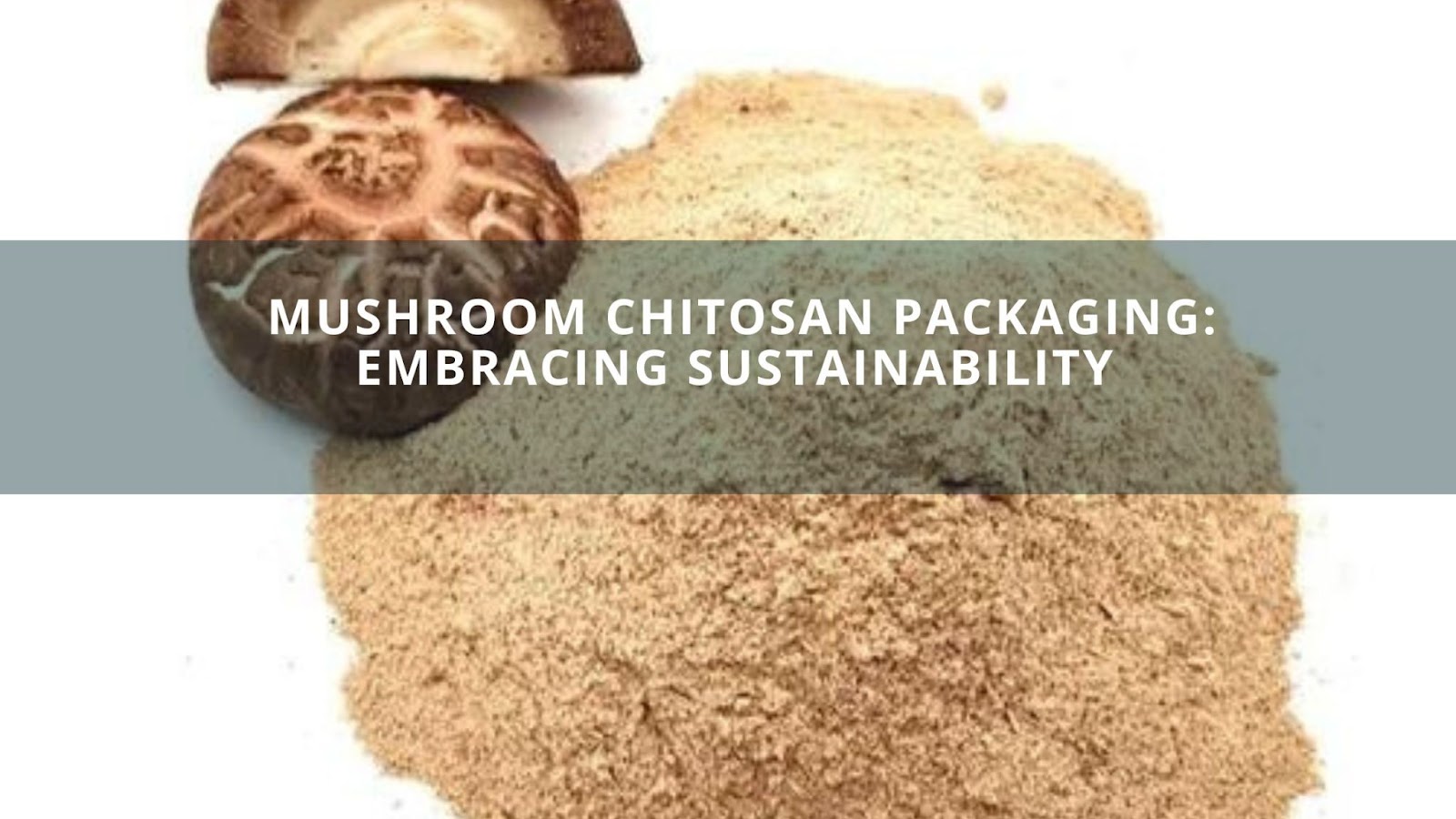The pressing need for sustainable practices has extended to every aspect of our lives, including packaging. Traditional packaging materials, such as plastics, have wreaked havoc on the environment, causing pollution, litter, and long-lasting waste. As a result, there is a growing demand for eco-friendly alternatives that minimize the impact on our planet.
One such solution that holds great promise is mushroom chitosan. Derived from the cell walls of mushrooms, it offers a sustainable alternative to traditional packaging materials. Mushroom chitosan possesses unique properties that make it an attractive option for eco-conscious consumers and businesses alike.
Mushroom chitosan exhibits desirable barrier properties, making it suitable for preserving the freshness and quality of various products. It can be processed into different packaging forms, including films, coatings, and foams, offering versatility in packaging applications.
With its potential to address environmental concerns, chitosan emerges as a promising solution for sustainable packaging. By reducing reliance on traditional materials and embracing this natural alternative, we can take a significant step towards a greener and more environmentally friendly future.
Understanding Chitosan
Chitosan is a natural polymer derived from the polysaccharide chitin, which is found in the exoskeletons of crustaceans like shrimp, crabs, and lobsters, as well as in the cell walls of certain fungi.
Mushroom chitosan refers specifically to chitosan obtained from mushrooms, making it a sustainable alternative to crustacean-derived chitosan for those concerned about animal welfare or allergenicity.
The extraction process for chitosan from mushrooms involves several steps. First, mushrooms are harvested and cleaned to remove dirt and impurities. Next, the mushroom cell walls are broken down through a combination of mechanical and chemical methods. This step allows for the release of chitin, which is then further purified and deacetylated, converting it into chitosan. The deacetylation process involves removing acetyl groups from chitin molecules, altering its properties and making it more soluble in acidic solutions.
Pharma grade chitosan possesses unique properties that make it well-suited for packaging applications.
- It is biodegradable and compostable, ensuring a reduced environmental impact compared to non-biodegradable materials.
- Chitosan exhibits excellent barrier properties against moisture, gases, and UV radiation, effectively protecting packaged products from spoilage and deterioration.
- Chitosan is antimicrobial, inhibiting the growth of certain bacteria and fungi, which can help extend the shelf life of perishable goods.
The Environmental Impact of Traditional Packaging Materials
Traditional packaging materials, particularly plastics, have had detrimental effects on the environment. Plastics are derived from fossil fuels, contributing to greenhouse gas emissions and climate change. Furthermore, plastics are non-biodegradable and persist in the environment for hundreds of years. This leads to pollution and litter in ecosystems such as oceans, rivers, and landfills.
Plastic packaging waste poses a significant challenge as it often ends up in landfills or as litter. Improper disposal or inadequate waste management systems result in plastic pollution, harming wildlife and marine life. Animals can ingest or become entangled in plastic, leading to injuries, suffocation, or even death. Moreover, plastics break down into microplastics, tiny particles that can accumulate in the environment, contaminate water sources, and enter the food chain, posing potential risks to human health.
The management of plastic waste presents numerous challenges. Recycling rates for plastics are relatively low, with many plastic products ending up in landfills or incineration facilities. Plastic recycling itself is complex and expensive due to the diversity of plastic types and the need for sorting and processing technologies. Single-use plastics, such as food packaging and beverage containers, contribute significantly to the waste stream.
The transportation and disposal of plastic waste require significant energy and resources, further contributing to environmental degradation. The accumulation of plastic waste in landfills takes up valuable space and releases greenhouse gases as plastics degrade anaerobically. Plastic incineration can also release harmful pollutants into the air, impacting air quality and human health.
Long-term consequences of plastic waste include the persistence of plastic particles in the environment, potential threats to biodiversity, and the depletion of finite resources. These issues highlight the urgent need to shift towards sustainable packaging alternatives to mitigate the environmental impacts associated with traditional materials.
By understanding the adverse effects and challenges posed by traditional packaging materials like plastics, it becomes evident why seeking sustainable alternatives, such as mushroom chitosan, is essential for a greener future.
Mushroom Chitosan as an Eco-Friendly Alternative
Mushroom chitosan offers a compelling solution to address the environmental concerns associated with packaging. Derived from renewable sources, it provides a sustainable alternative to traditional materials like plastics. By utilizing mushroom chitosan, the reliance on fossil fuels is reduced, resulting in lower carbon emissions and decreased environmental impact throughout the packaging lifecycle.
One of the remarkable attributes of chitosan is its biodegradability and compostability. When discarded, chitosan packaging can naturally break down into organic compounds through the action of microorganisms. This biodegradation process eliminates the long-lasting waste problem caused by non-biodegradable materials like plastics. Mushroom chitosan can be composted, further contributing to waste reduction by transforming into nutrient-rich soil amendments.
Mushrooms themselves are inherently renewable resources. They are cultivated through a sustainable process that requires minimal water, energy, and land compared to other crops. Its cultivation can be done indoors, utilizing substrates made from agricultural waste materials. This closed-loop system allows for the efficient use of resources, reducing the environmental footprint associated with mushroom production.
Mushrooms can be grown in controlled environments year-round, making them an accessible and consistent source of chitosan. This potential for sustainable cultivation ensures a stable supply of chitosan for packaging applications without depleting natural resources or causing deforestation.
The renewable nature of mushrooms and the use of chitosan in packaging align with the principles of circular economy and sustainable practices. By embracing chitosan as an eco-friendly alternative, we can significantly reduce the environmental impact associated with packaging materials, contributing to waste reduction, lower carbon emissions, and a healthier planet.
Current Research and Future Perspectives
Ongoing research in the field of chitosan packaging is focused on expanding its applications and improving its properties. Scientists and researchers are exploring ways to enhance the mechanical strength and flexibility of chitosan films to meet the requirements of different packaging needs. They are also investigating methods to improve the moisture resistance and gas barrier properties of mushroom chitosan to ensure optimal preservation of packaged products.
Studies are being conducted to understand the degradation behavior of chitosan in various environments, including soil and marine ecosystems. This research aims to assess the complete life cycle of mushroom chitosan packaging and its impact on the environment, further solidifying its eco-friendly credentials.
The future holds promising prospects for chitosan packaging. Further advancements and innovations are expected in terms of material properties and manufacturing processes. Researchers are exploring the possibility of incorporating additives or modifying the chitosan structure to enhance its functional properties, such as increased heat resistance, improved mechanical strength, and enhanced barrier performance.
Manufacturing processes may also be optimized to ensure scalability and cost-effectiveness. This includes the development of efficient extraction methods, process automation, and the utilization of waste streams from cultivation to minimize resource consumption.
Conclusion
By adopting mushroom chitosan packaging, with the help of chitosan suppliers we can contribute to the reduction of plastic waste, pollution, and carbon emissions.
The ongoing research and developments in the field offer exciting opportunities to further enhance the material’s properties and manufacturing processes, ensuring its suitability for a wide range of packaging applications.
It is crucial to recognize the significance of chitosan as a sustainable packaging material and its potential to drive positive change in the industry. By embracing chitosan and encouraging its adoption, we can create a more environmentally conscious and responsible packaging ecosystem.
Continue to explore, support, and implement chitosan in the packaging industry to pave the way for a greener and more sustainable future.







